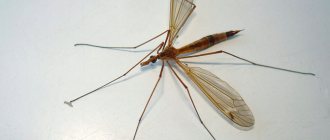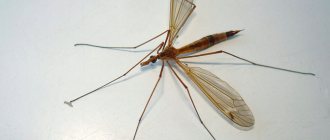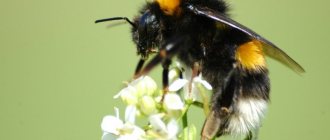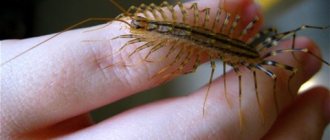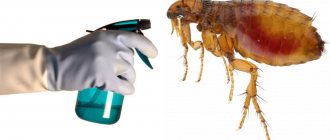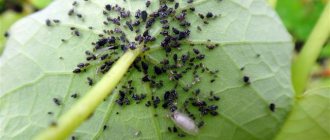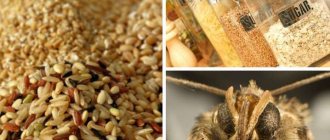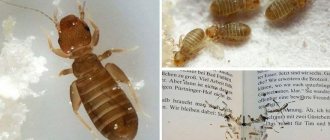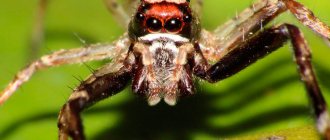The book false scorpion lives in nature, but now there are fewer and fewer such natural habitats, so it has moved into houses and apartments. Usually these insects live in damp, dark and secluded places, for example, under a stone, in a cave, in a tree post and other places hidden from human eyes. That’s why they are rarely seen in the wild, but the appearance of a bookish specimen in an apartment throws many into fear, panic and the search for a saving slipper or broom. How dangerous is a false scorpion for humans?
Book false scorpion as part of wildlife
This insect cannot be called a scorpion due to the fact that it is more like a spider, especially without poisonous glands. The abdominal part is more reminiscent of a tick, but the walking legs and feeding method are the spitting image of a spider. The body of the false scorpion is very small - approximately 3 mm, and the largest book "scorpion" was 12 mm in size. This already makes you relax, what can this little guy do?
The weapon of the spider-like insect is chelicerae, claws that allow this predator to attack the victim, pierce it and suck out all the life-giving moisture. It sounds scary, but people are not included in its diet.
An insect's senses are not developed in the same way as a human's, and therefore the claws of a false scorpion serve as all sense organs at the same time. In fact, because of these claws, the spider-like bug was menacingly nicknamed the scorpion. Their size is the same as the body, and therefore it is difficult to ignore this weapon. However, unlike scorpions, its false relatives do not have a tail or that very poisonous sting. So the book insect does not justify its comparison with the sporpion, which is dangerous to human life.
Spreading
More than 3,300 species of pseudoscorpions are known, divided into 430 genera, and new species are regularly described. They are found everywhere, including cold regions such as Northern Ontario, high altitudes and deep caves. Their population reaches its greatest density in the tropics, where they have even penetrated isolated islands. Thus, about 25 endemic species of pseudoscorpions were discovered in the Canary Islands. Different species choose tree bark and hollows, leaves and needles, near-soil layers and caves, the seashore and the tidal zone as their habitat. They can also be found under rocks or in rock cracks.
The species most commonly found in human homes is Chelifer cancroides, which can be found in dusty rooms and inside books. Their food is small aphids and house bugs.
How do book insects reproduce?
This species of arachnid reproduces once a year through sexual intercourse. This is not just some kind of intercourse, but a whole ceremony. Males circle around their chosen ones in a dance of love, moving their abdomen from side to side and dancing with their walking legs.
After the babies are born, the mother will die, sacrificing herself to feed the little bugs. Her children will also be able to become parents in one year, and the life expectancy of book scorpions is approximately three years.
Cruciferous flea beetle in the garden: 4 safe ways to control the pest
Aldabrinus aldabrinus
Wikipedia reports that this species has chosen to live on the eastern coast of the African continent as its habitat. They also moved to some islands of the Indian Ocean.
A large population lives in the Seychelles. They got their name from the Aldabra Atoll. They prefer to settle in open, dry areas.
They hunt insects. In moments of danger, they prefer to flee, hiding under stones, fallen leaves, and crevices in the soil.
What are they?
In houses and apartments, false scorpions choose to live in a place where it is quiet and calm, as well as a lot of dust and all kinds of living creatures. These are bookcases, shelves with various papers and other storage areas for the remains of human activity and their domestic insects. That is, if there is a place where a rag for wiping dust has reached it, it means that there is definitely this carrier of threatening claws there. It is very, very difficult to notice a false scorpio. This usually happens during spring cleaning, when things are carefully moved from one place to another.
Another favorite room of bookish individuals is the bathroom. Here, most often, the lights are turned off, there is moisture, which means there is something to profit from. In addition, rarely does anyone immediately wash out the bath with bleach after a shower, and there are various pieces of skin left on which small insects converge. It is difficult to notice claws in the bathroom, but if you look closely immediately after turning on the light, you can see some movements - most likely these are false scorpions running away from the prying eyes of the apartment owner.
Reasons for appearance
It’s easy to figure out why the population of unusual arachnids is increasing in an apartment if we remember the food that pseudoscorpions prefer.
Small creatures with claws willingly eat:
- ticks;
- larvae of flies and beetles;
- tiny spiders;
- dust louse;
- springtail;
- bread worms;
- nematodes;
- soil mites;
- small brown carpet beetles;
- particles of dead epidermis that fell into the bath during bathing.
Conclusion: the main factor that attracts false scorpions into a home is insufficient cleaning of the apartment. Dust, cobwebs in the corners, on bookshelves, inside cabinets, between walls and sofas, armchairs, chests of drawers, on mezzanines, accumulation of unnecessary newspapers, old paper - an ideal habitat for small creatures with large claws. After establishing order and the disappearance of food for tiny creatures, false scorpions will have nothing to profit from, they will disappear from the home.
Are they dangerous to human life and health?
This question is often asked after an entire family of insects has been completely exterminated by cleaning or a slipper, a broom and other “saving things.” In fact, these bugs are only so scary in appearance; their small size and other food preferences make false scorpions absolutely safe for humans. There are, of course, pros and cons of living together with these insects.
Aphids on roses: 7 effective methods to combat them
Pros or benefits of book false scorpions:
- These insects are real home orderlies. They feed on bugs that are harmful to humans, but they themselves are harmless arachnids. False scorpions eat ticks, book and dust lice, small beetles and other living creatures that apartment residents don’t even know about. Thanks to their pincers, they pierce the bodies of their victims and eat them in a spider-like manner.
- The diet of false scorpions not only frees the living space from harmful insects, but also eliminates allergens and other microparticles. The book specimen is small in size, and therefore all things remain in their places and do not affect a person’s life in any way, but there is much less dust. After all, what is dust? These are dead particles of human skin, all sorts of small insects and their metabolic products.
- Bookbugs reproduce only once a year, and therefore an invasion of beetles in an apartment is extremely rare.
- False scorpions do not attack humans; they are simply not interested in us.
Cons, aka harm from cohabitation with bookish false scorpions:
- These beneficial bugs kill insects and protect people from allergic reactions; their waste products can also cause unknown deterioration in health. So people with hypersensitivity to all things False Scorpio associate it with negative emotions and causing harm.
- If the apartment or house is large, then a small colony of book insects will not harm, but for residents of a one-room apartment, the annually increasing population will be very disturbing.
- Yes, false scorpions themselves will not attack, but if you accidentally touch him or tear out his walking leg, he may bite.
- The appearance can irritate or frighten a person, and therefore the proximity of beetles and nervous people must be excluded.
Catching belt and 3 more ways to protect trees from garden pests
Preventive measures
First of all, you need to take care of order and cleanliness in your home, which will not attract various insects that are harmful and dangerous to humans. When there is a lot of accumulated dust in the apartment, which indicates that the apartment has not been wet cleaned for a long time, then there is a high probability that dust mites will appear in it, which will immediately interest false scorpions. In addition, you should look into corners and hard-to-reach places as often as possible to remove cobwebs and dust. If you have a lot of old unnecessary things stored, then it is better to throw them in the trash or donate them to people who do not even have such unnecessary old things. In other words, you need to monitor the technical condition of your home, as well as the furniture and things that are in the apartment or stored. It is also necessary to take care of the proper storage of things so that various insects do not infest them, and for this you need to constantly ventilate them.
If a creature that looks like a spider or a tick, with large claws, was noticed in the apartment, then it’s time not to grab your slipper to kill it, but to think about the reasons for such an appearance. This insect is not interested in food products, furniture, upholstery, clothing, and even less so in humans. This insect appeared in a person’s home to help him clear his apartment of other uninvited guests who pose a danger to humans. This is a signal that you need to do high-quality cleaning in the apartment and identify parasites that have managed to settle next to a person. Having expelled such pests from the apartment or destroyed such pests, the false scorpions themselves will leave the home, since they will not have anything to eat.
What to do when meeting?
- If you see a false scorpion, calm down, it is not dangerous. Most likely he is also scared, frozen and pretending to be dead. Play along with him, turn off the light and enter the room after 1 minute. The book scorpion will no longer be visible.
- The false scorpion moves slowly and, if you decide to kill it, it can show sprinting abilities and try to escape. And the false scorpio can run sideways, back and forth, so you can expect anything from him.
- If a false scorpion bites, then you just need to lubricate the area with some kind of disinfectant. It does not have any poison, it cannot cause burns or allergies, and therefore there is no point in panicking and nervously calling an ambulance.
Biological description of the species
The family of harvest spiders (long-legged spiders) belongs to the order of spiders - Araneae, and the harvest spiders (long-legged spiders) belong to the order Opiliones. Although they are all arachnids and have a similar structure, they are fundamentally different creatures, although very similar in appearance. Because of this similarity, identical names appeared, which often leads to confusion.
For example, the centipede, which is a true spider, spins a web, while the cornskin spider does not. In addition, the harvest spider has 8 eyes on its round body – the prosoma: two of them are in the middle (medial), and the rest are on the edges of the abdomen on small outgrowths. In some specimens living in dark caves, the number of eyes may be reduced as unnecessary. Haymakers always have only two eyes.
Another difference between the long-legged spider and the haymaker can be seen if you carefully examine their body. In both, it consists of a rounded abdomen and chest, smoothly turning into the head. These two significant parts are connected by a kind of neck-stalk. But in a true haymaker, unlike a spider, this transition is very wide, so it seems that in the haymaker the whole body consists of one single section, while in the centipede each one is clearly expressed.
There are 8 legs on the cephalothorax. Moreover, their size is often uneven: the harvest spider actively uses the longest pair as antennas. He uses them to touch the objects around him and puts things in order in his web. Moreover, each of the legs can fall off in case of danger: for example, if a lizard grabs it. Although the lost limb does not regenerate, centipedes cope perfectly well without them: individuals are often found that move at a fast pace even on 4 legs.
How to fight?
- Clean your home more often, do not create ideal conditions for their habitat - do not allow dust and open damp areas.
- Ventilation of the house should be regular, and the floors should be washed not with plain water, but with the use of detergents.
- From time to time it is necessary to carry out special measures to combat domestic insects.
The false scorpion is not dangerous to human life and is even quite useful in household use. But if you still don’t like insects, then you need to reconsider your general cleaning schedule.
Prevention measures
The main task of owners who do not want to put up with a colony of false scorpions is to maintain order throughout the apartment. Dust, cobwebs in the corners, rare ventilation of things from the closet, reluctance to look into hard-to-reach corners to remove debris provoke the appearance of various types of bugs, spiders and arthropods.
When you encounter an unusual creature that combines the characteristics of an arachnid and a tick, you should not immediately grab your slippers or newspaper to kill the “formidable” creature several millimeters in size. It’s worth figuring out why arachnids live in the apartment. Order, regular cleaning, attention to hard-to-reach places, cabinets, bookshelves will reduce the likelihood of colonization not only by false scorpions, but also by other insects.
Squad Classification[ | ]
The number of genera and species is given in parentheses.
Suborder Epiocherata
Suborder Epiocherata
Chthonioidea
- Chthoniidae (31, 605)
- †Dracochelidae - one fossil species (Devonian period)
- Lechytiidae (1, 22)
- Tridenchthoniidae (17, 68)
Feaelloidea
- Feaellidae (1, 12)
- Pseudogarypidae (2, 7)
Suborder Iocheirata
Suborder Iocheirata
infraorder Hemictenata
Neobisioidea
- Bochicidae (10, 38)
- Gymnobisiidae (4, 11)
- Hyidae (3, 9)
- Ideoroncidae (9, 53)
- Neobisiidae (34, 498)
- Parahyidae (1, 1)
- Syarinidae (16, 93)
infraorder Panctenata
Elassommatina group
Cheliferoidea (224, 1261)
- Atemnidae (19, 172)
- Cheliferidae (59, 292)
Book false scorpion (Chelifer cancroides)
Chernetidae (112, 643) False scorpion (Chernes cimicoides F.)
Withiidae (34, 154)
Sternophoroidea
Sternophoridae (3, 20)
group Mestommatina
Garypoidea
- Cheiridiidae (6, 69)
- Garypidae (10, 74)
- Geogarypidae (3, 61)
- Larcidae (2, 13)
- Pseudochiridiidae (2, 12)
Olpioidea
- Menthidae (4,
- Olpiidae (53, 329)
Interesting Facts
- The first extant description of pseudoscorpions was by Aristotle, who may have discovered them in library scrolls where they fed on hay-eaters. Robert Hooke, in his 1665 work, Micrographia, mentions certain "land crabs". A mention of a similar arthropod can be found in George Adams Sr.
- The oldest fossil organism, identified as a member of the order Pseudoscorpioideae, dates back to 380 million years ago (Devonian period). This fossil has all the characteristics of a modern pseudoscorpion, indicating that this order developed during the early days of the appearance of land animals.
- False scorpions living in a person’s home can be considered real orderlies of the apartment, freeing its inhabitants from the presence of various parasites, the existence of which the owners do not even suspect.
- It is not worth purposefully encouraging the growth of a colony of false scorpions; this may have the opposite effect when their molting products and excrement begin to create an allergenic background in the apartment.
- False scorpions are prone to phoresy - the unintentional use of various animals as vehicles. This happens when a hungry false scorpion attacks an object that is too large, for example, a fly, which flies away, carrying it with itself. It happens when, during the hunt for ticks that parasitize the bodies of animals and birds, false scorpions end up on their hosts and, thus, make forced migrations. The phenomenon of phoresy mainly applies to female pseudoscorpions, who feed especially intensively during the breeding season and attack large prey, which they are unable to defeat.
Video
Why you can't keep a fern at home
Signs vary greatly regarding the benefits and harms of keeping ferns at home. However, the explanations for its negative properties are quite logical.
The most common esoteric opinions are as follows:
- It is believed that you cannot plant a plant obtained from the forest on your plot. From the point of view of esotericists, fern has magical properties, especially in the wild. If you take a flower from its “native” place, it will begin to cause trouble.
- Regarding the transfer of a plant previously kept in the apartment to your site, opinions are also divided. The main reason is the ability of the fern to draw energy from space. If at home a plant can be powered by household appliances, in the garden it will begin to draw vitality from crops growing nearby.
- The fern absorbs a large amount of oxygen, so you should not place it in the bedroom. Otherwise, it will cause harm in the form of headaches.
- If a plant makes you feel unwell, you should not continue to store it in the house. In the future, the harm from it will only increase. If this happens, you should get rid of the flower.
Since beliefs do not exclude contradictions, you should only pay attention to your well-being: if everything is good, then the plant can be considered useful. The same can be applied to a flower in a summer cottage
Application in the field of cosmetology
Peony is a storehouse of useful substances that are used in skin care products. The plant has a tonic effect, tightens, nourishes and moisturizes the skin, fights signs of aging and loss of elasticity.
Preparing a cosmetic product is not difficult. You need to take high-fat sour cream and mix it with chopped peony leaves. The essential oil contained in the leaves will give the skin a velvety feel, and will also fill and smooth out shallow wrinkles.
For the care of problematic facial skin, i.e. in the presence of acne and inflammation, use a simple decoction based on fresh flower buds. The product is used several times a day by applying to previously cleansed skin.
Also, a dry mixture of finely ground leaves is well suited for preparing masks, which, with constant use, have whitening and restorative properties and effectively even out the complexion.
Shampoos, when adding a decoction based on this plant, help fight dandruff, give hair shine along the entire length, increase the activity of hair follicles and strengthen them.
The essence of the procedure
First, it’s worth understanding what quartzing is and how this process will help in disinfecting the room.
Quartzization is a procedure that involves treating a room with ultraviolet radiation. The quartz treatment process uses a quartz or bactericidal lamp. It turns out that with the help of light we can clear almost any area of pathogens. This uses ultraviolet light, which, in moderate doses, is not dangerous to humans, since we receive its dose from the sun every day.
Important! Ultraviolet destroys microorganisms not only on some surfaces, but also in the air. To carry out the quartzing procedure, you need to purchase a special lamp that will emit ultraviolet light.
This device is sold not only in medical stores. You can purchase the device in large supermarkets or in stores that sell equipment.
To carry out the quartzing procedure, you need to purchase a special lamp that will emit ultraviolet light. This device is sold not only in medical stores. You can purchase the device in large supermarkets or in stores that sell equipment.
When choosing a product, you should take into account the power required to clean a particular quadrature. That is, you need to know the area of the room in order to buy the lamp with the optimal power.
To decontaminate your home, use a melamine sponge, and also use mustard, tar soap, cow's milk, and soda as a detergent for cleaning the house.
Next, you need to remove all animals and plants from the room, since the device emits quite strong radiation that can harm living beings. After this, the person who will turn the lamp on and off should wear sunglasses, since ultraviolet radiation can damage the eyes even with short-term contact.
After this, you should turn on the lamp and leave the room for half an hour. Exactly after 30 minutes, you should go into the room being treated, turn off the device and wait until it cools completely. Only after this can the treatment be repeated in other rooms.
Important! After treatment with a lamp that emits ozone, be sure to ventilate the room. It is worth mentioning separately that it is better to use bactericidal lamps, as they are more powerful and disinfect the room better
It is worth mentioning separately that it is better to use bactericidal lamps, as they are more powerful and disinfect the room better.
Notes[ | ]
- ↑ 12
Pennsylvania State University, Department: Entomological Notes: Pseudoscorpion Fact Sheet - Endemic invertebrates (undefined)
(inaccessible link). Ascension Island Conservation Center. Archived from the original on May 9, 2010. - Pseudoscorpions (undefined)
. Agricultural Research Council (South Africa). Archived from the original on February 22, 2012. - Volker Mahnert.
A nature's treasure: pseudoscorpion diversity of the Canary Islands, with the description of nine new species (Pseudoscorpiones, Chthoniidae, Cheiridiidae) and new records (English) // Revista Ibérica de Aracnología: journal. - 2011. - Vol. 19. - P. 27-45. Archived from the original on March 4, 2022. - Adams, George (1787): Essays on the Microscope. First edition. (London: Robert Hindmarsh)
- Jason A. Dunlop, Danilo Harms.
The fossil history of pseudoscorpions (Arachnida: Pseudoscorpiones) (English) // Fossil Record. — 2017-08-09. - Vol. 20, iss. 2. - P. 215-238. — ISSN 2193-0066. - William A. Shear, Wolfgang Schawaller & Patricia M. Bonamo.
Record of Palaeozoic pseudoscorpions (English) // Nature. - 1989. - Vol. 342, no. 6242. - P. 527-529. - doi:10.1038/341527a0. - Mark LI Judson.
Reinterpretation of Dracochela deprehendor (Arachnida: Pseudoscorpiones) as a stem-group pseudoscorpion (English) // Palaeontology (English) Russian.. - 2012. - Vol. 55, iss. 2. - P. 261-283. — ISSN 1475-4983. - doi:10.1111/j.1475-4983.2012.01134.x. - Wolfgang Schawaller, William A. Shear & Patricia M. Bonamo.
The first Paleozoic pseudoscorpions (Arachnida, Pseudoscorpionida) (English) // American Museum Novitates (English) Russian.. - American Museum of Natural History, 1991. - Vol. 3009.
Favorite places to live
The more carpets, upholstered furniture and other textile decorations and interior items there are in the house, the more and faster dust will form in it. For example, carpets are a favorite habitat for dust mites. A huge amount of “provisions” always settles on them. The next photo shows dust mites that feel great among carpet textile fibers.
Separately, it is worth mentioning feather and down pillows, as well as mattresses. Scientists managed to have a hand here too, calculating that up to two million dust mites constantly live in an ordinary average double bed. And feather and down fillings, if there is a lack of food, can themselves become food for these microscopic creatures.
Household and other appliances deserve a special mention. Old monitors, stereos and DVD players are potential cities and breeding grounds for dust mites. There is always a lot of dust among the microcircuits, capacitors, resistors and other radio equipment, but if there is a lot of dust, and no one cleans it out for a long time, mites live in it especially freely.
Disinsection of premises
Treatment for lice and nits at home is mandatory to prevent the spread of infection and re-infection. The choice of an effective remedy depends on the degree of infection.
Aerosols against parasites
Effective means:
- Raptor;
- Raid;
- Clean house;
- Executioner;
- Get;
- Karbofos;
- Dichlorvos neo;
- Tetrix.
The aerosol is effective for 2 hours. Gradually loses its poisoning ability. But this is enough to destroy lice that accidentally ended up on furniture and the floor.
Concentrates are much more powerful and last for about a week. Provide reliable prevention against re-infection. It is advisable to use when the entire family is infected with a large number of parasites.
During processing, personal safety measures must be observed:
- There should be no other people or pets in the room.
- A few hours after the procedure, you need to thoroughly ventilate and carry out wet cleaning with the addition of soda. Spray the bed thoroughly. You can also clean it of parasites with alcohol tincture.
To get rid of lice on the head, use a special product and, if necessary, wear a special cap. In Moscow, as in other cities, you can buy a drug against lice at any pharmacy. The products are available in the form of shampoo, spray, ointment. After the procedure, comb your hair with a comb and remove nits with a fine-toothed comb. For convenience, you can use a lice comb.
Simultaneous treatment of the head, clothes, and bedding guarantees a quick result, but does not protect against re-infection with lice. Preventive measures must be strictly observed.
Common fleas (Pulicidae). Photo
These are blood-sucking insects. They do not have wings, despite popular belief. Parasites do not fly, but jump high (up to 1 m in height). They have long hind limbs, which makes it possible to distinguish between such individuals and ticks, but this is noticeable only upon closer examination, and not during the movement of pests. Body color is dark brown, almost black. The length of the parasite varies from 1 to 5 mm, representatives of some species reach 10 mm (females). Such parasites live on the fur and in the nests of their owners.
Appearance of a flea
Fleas feed on human blood
Flea bite marks on the body
Video: How dangerous are fleas, what diseases do they carry?
To understand how such insects differ from ticks, it is recommended to study their vital functions. You can watch the video below, which reveals this information.
Medicines
Peony can be used as a therapeutic and prophylactic agent in the form of a tincture. An alcohol tincture based on peony evasive (which is popularly called “Maryin root”) can be purchased in pharmacies.
Maryin root is rare, but the medicine is inexpensive. The plant was used in ancient times by our ancestors to combat headaches and toothaches; it was also used to make culinary spices.
If you have this type of peony, you can prepare the tincture yourself. In order to make it, all components are needed except the bud, namely: stems, roots and rhizomes. It is best to collect ingredients at the height of flowering, because... It is during this period that the life of the plant is most active, which allows you to get the maximum benefit from its components.
The preparation process is simple and consists in the fact that the grass and roots need to be poured with alcohol and left in a cool place for several weeks. Then the resulting solution must be filtered through cheesecloth and poured into a dark glass vessel.
The tincture should also be stored in a cool, dark place. The drug is taken twenty drops, three times a day before meals. The duration of the course is usually about a month, but also depends on the characteristics of the disease.
In addition to alcohol, you can also make a water tincture based on peony. To do this, you will need a spoon of dry crushed roots and two glasses of boiling water. The infusion process lasts about half an hour. The infusion should be taken three times a day before meals in the amount of two tablespoons.
